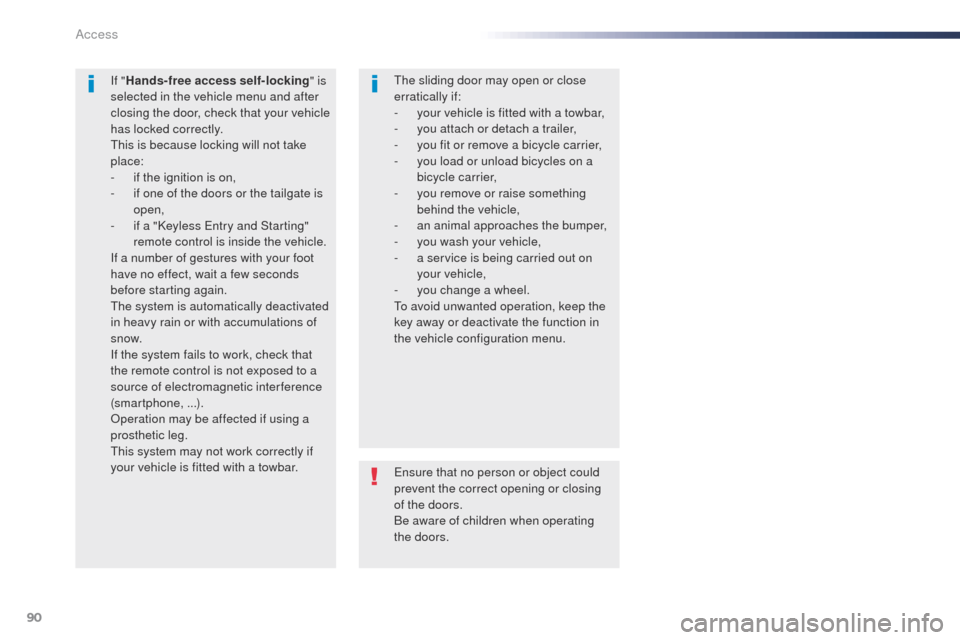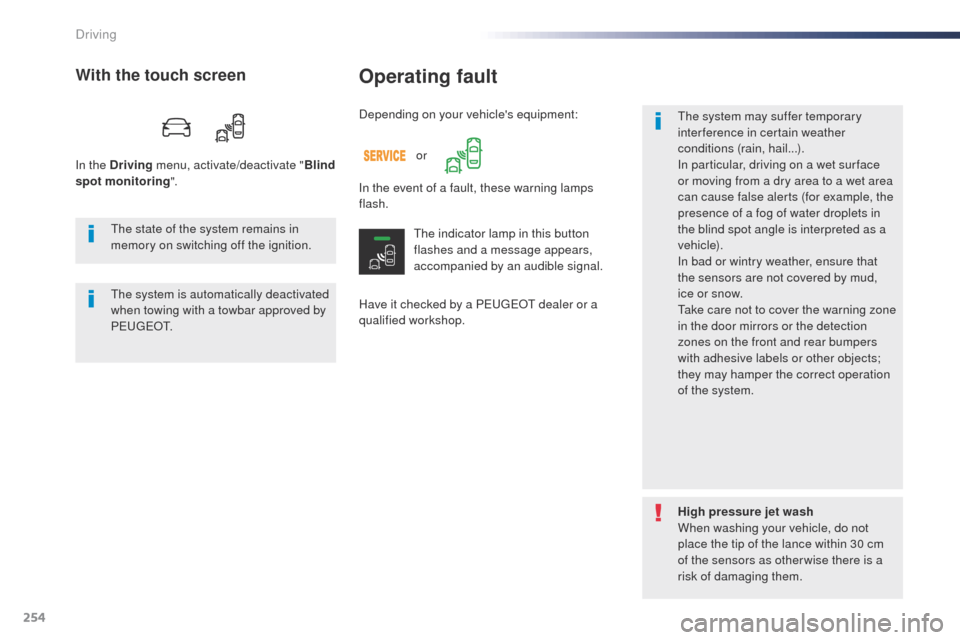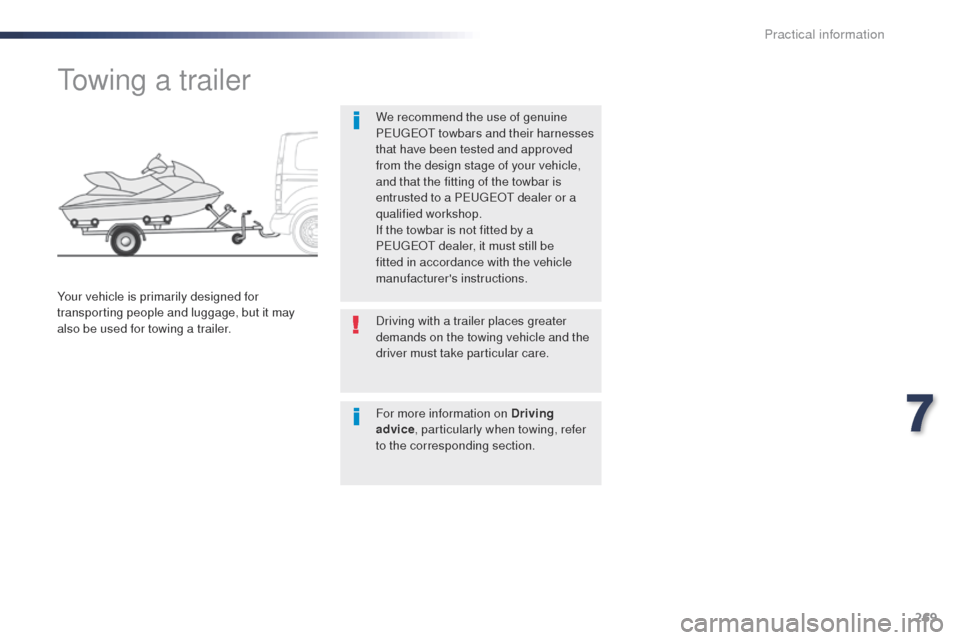2016 Peugeot Expert VU tow bar
[x] Cancel search: tow barPage 5 of 520

.
.
Driving recommendations 196
Starting-switching off the engine, manual key, remote control
1
99
Starting-switching off the engine, "Keyless
e
n
try and Starting"
2
02
Parking brake
2
05
Hill start assist
2
06
5-speed manual gearbox
2
07
6-speed manual gearbox
2
07
Gear ef ficiency indicator
2
08
Automatic gearbox
20
9
ele
ctronic gearbox
2
14
Stop & Start
2
18
Head-up display
2
22
Memorising speeds
2
24
Speed limit recognition
2
25
Speed limiter
2
29
Cruise control
2
32
Dynamic cruise control
2
36
Collision Risk Alert and Active Safety Brake
2
43
Lane departure warning system
2
48
Fatigue detection system
2
50
Blind spot monitoring system
2
52
Parking sensors
2
55
Reversing camera, interior mirror
2
58
180° rear vision
2
59
Under-inflation detection
2
62Fuel tank
2 65
Diesel misfuel prevention 26
6
Snow chains
2
68
to
wing a trailer
2
69
en
ergy economy mode
2
70
Accessories
271
Roof bars / Roof rack
2
73
Changing a wiper blade
2
74
Bonnet
276
Diesel engine
2
77
Checking levels
2
78
Checks
281
AdBlue
® and SCR system
(BlueHDi Diesel) 2 83
Warning triangle (stowing)
2
87
to
ol box
2
87
te
mporary puncture repair kit
2
90
Changing a wheel
2
96
Changing a bulb
3
03
Changing a fuse
3
16
12 V battery
3
21
to
wing
325
Running out of fuel (Diesel)
3
27Dimensions
328
en
gines
332
Weights
332
Identification markings
3
37
Driving
Practical information
In the event of a breakdownte chnical data
emergency or assistance 338
Pe ugeot Connect Nav 3 41
P
e
ugeot Connect Radio
4
29
Bluetooth
® audio system 4 83
Audio equipment and telematics
Alphabetical index
Contents
Page 7 of 520

5
Number plate lamp 311, 314
- s ide-hinged doors
-
tailgate
Reversing camera
2
58
180º Rear vision
2
59 -261
Changing rear bulbs
3
10, 315
Rear lamps (side-hinged doors)
3
03, 310 -312
Rear lamps (tailgate)
3
03, 313 - 315
3
rd brake lamp 3 11, 314
-
s ide-hinged doors
-
tailgate
Warning triangle
2
87
te
mporary puncture repair kit
2
90-295
Spare wheel, jack, changing a wheel
2
96-302
Inflation, pressures
2
95, 337Door mir ror s
14
3 -14 4
-
manual
-
electric
Demisting-defrosting the mirrors
1
33
Blind spot monitoring system
252-254
Fixed crew cab
1
17-118
Manual sliding side door(s)
7
5 -77, 84- 86
el
ectric sliding
side door(s)
7
8 - 83, 84- 86
Hands-free sliding side door(s)
87
-90
Manual child lock
1
94
el
ectric child lock
1
94
Rear window child lock
1
95
Direction indicator side repeaters
3
05
Accessories
271-273
Roof bars / Roof rack
2
73
to
wing
325-326
tr
ailer towbar
1
98, 269
Rear parking sensors
2
55-257
Side-hinged doors
9
1-93
ta
ilgate
9
4
Demisting-defrosting the rear screen
1
34
exterior (continued)
.
over view
Page 92 of 520

90
ensure that no person or object could
prevent the correct opening or closing
of the doors.
Be aware of children when operating
the doors.
If "
Hands-free access self-locking " is
selected in the vehicle menu and after
closing the door, check that your vehicle
has locked correctly.
th
is is because locking will not take
place:
-
i
f the ignition is on,
-
i
f one of the doors or the tailgate is
open,
-
i
f a "Keyless
e
n
try and Starting"
remote control is inside the vehicle.
If a number of gestures with your foot
have no effect, wait a few seconds
before starting again.
th
e system is automatically deactivated
in heavy rain or with accumulations of
snow.
If the system fails to work, check that
the remote control is not exposed to a
source of electromagnetic interference
(smar tphone, ...).
op
eration may be affected if using a
prosthetic leg.
th
is system may not work correctly if
your vehicle is fitted with a towbar.
th
e sliding door may open or close
erratically if:
-
y
our vehicle is fitted with a towbar,
-
y
ou attach or detach a trailer,
-
y
ou fit or remove a bicycle carrier,
-
y
ou load or unload bicycles on a
bicycle carrier,
-
y
ou remove or raise something
behind the vehicle,
-
an
animal approaches the bumper,
-
y
ou wash your vehicle,
-
a s
ervice is being carried out on
your vehicle,
-
y
ou change a wheel.
to a
void unwanted operation, keep the
key away or deactivate the function in
the vehicle configuration menu.
Access
Page 200 of 520

198
When towing
Distribution of loads
F Distribute the load in the trailer so that the
heaviest items are as close as possible to
the axle and the nose weight approaches
the maximum permitted without exceeding it.
Air density decreases with altitude, thus
reducing engine performance. Above
1 000 metres, the maximum towed load must
be reduced by 10
% for every 1 000 metres of
altitude.
Side wind
F take into account the increased sensitivity to side wind.
Cooling
towing a trailer on a slope increases the
temperature of the coolant.
As the fan is electrically controlled, its cooling
capacity is not dependent on the engine speed.
F
t
o l
ower the engine speed, reduce your
speed.
th
e maximum towed load on a long incline
depends on the gradient and the ambient
temperature.
In all cases, keep a check on the coolant
temperature.
F
I
f the warning lamp and the
STOP warning lamp come on,
stop the vehicle and switch off
the engine as soon as possible.
Braking
towing a trailer increases the braking distance.to a void overheating of the brakes, the use of
engine braking is recommended.
Ty r e s
F Check the tyre pressures of the towing vehicle and of the trailer, observing the
recommended pressures.
Lighting
F Check the electrical lighting and signalling on the trailer and the headlamp beam
height of your vehicle.
For more information on Weights
, refer
to the corresponding section.
th
e rear parking sensors will be
deactivated automatically to avoid the
audible signal if a genuine P
e
ugeot
towbar is used.
If the ambient temperature is high, it
is recommended that the engine be
allowed to idle for 1 to 2 minutes after
the vehicle comes to a stop, to facilitate
its cooling. For more information on Adjusting the
headlamp beam height
, refer to the
corresponding section.
Driving
Page 256 of 520

254
Operating fault
Have it checked by a Peugeot dealer or a
qualified workshop.
th
e system may suffer temporary
interference in certain weather
conditions (rain, hail...).
In particular, driving on a wet sur face
or moving from a dry area to a wet area
can cause false alerts (for example, the
presence of a fog of water droplets in
the blind spot angle is interpreted as a
vehicle).
In bad or wintry weather, ensure that
the sensors are not covered by mud,
ice or snow.ta ke care not to cover the warning zone
in the door mirrors or the detection
zones on the front and rear bumpers
with adhesive labels or other objects;
they may hamper the correct operation
of the system.
Depending on your vehicle's equipment:
With the touch screen
In the Driving
menu, activate/deactivate " Blind
spot monitoring ".
In the event of a fault, these warning lamps
flash.
th
e indicator lamp in this button
flashes and a message appears,
accompanied by an audible signal.
th
e state of the system remains in
memory on switching off the ignition.
th
e system is automatically deactivated
when towing with a towbar approved by
P
e
u g e o t .
High pressure jet wash
When washing your vehicle, do not
place the tip of the lance within 30 cm
of the sensors as otherwise there is a
risk of damaging them.
or
Driving
Page 258 of 520

256
Front parking sensors
As an addition to the rear parking sensors, the
front parking sensors are triggered when an
obstacle is detected in front and the speed of
the vehicle is still below 6 mph (10 km/h).
th
e front parking sensors are interrupted if
the vehicle stops for more than three seconds
in for ward gear, if no further obstacles are
detected or when the speed of the vehicle
exceeds 6 mph (10 km/h).
With the audio system
Deactivation / Activation
Deactivation or activation of the system is done
via the vehicle configuration menu.
th
e sound from the speakers (front or
rear) indicates whether the obstacle is
in front or behind.
th
e system will be automatically
deactivated where a towbar or towbar-
mounted bicycle carrier is fitted
(vehicle fitted with a towbar installed as
recommended by a P
e
ugeot dealer).
In the " Personalisation-configuration " menu,
activate/deactivate " Parking assistance ".
With the touch screen
In the Driving menu, activate/deactivate
" Parking sensors ".
Without audio system
to deactivate the system:
F
P
ress the button, its indicator
lamp comes on, the system is
deactivated.
to a
ctivate the system: F
P
ress this button, the indicator
lamp goes off, the system is
activated
Driving
Page 263 of 520

261
Activation
Activation is automatic on engaging reverse.the function is displayed in the touch screen.
to c
lose the window displayed, press on the
red cross at the top left of the screen.
on d
isplay of the sub-menu, select one of the
four views:
"Standard view".
"180° view".
"Zoom view".
"A
u
to
m
o de".
You can choose the display mode at any time
by pressing on this area. Check the cleanliness of the camera
lenses regularly.
Periodically clean the reversing camera
with a soft dry cloth.
"AUTO mode"
this mode is activated by default.us
ing sensors in the rear bumper, the
automatic view allows a change from the rear
view to the view from above as an obstacle is
approached during a manoeuvre.
th
e system is automatically deactivated
when towing a trailer or carrying a
bicycle on the towbar (vehicle fitted with
a towbar installed as recommended by
the manufacturer).
Quick start mode
this mode displays, as quickly as possible, the
contextual view (left-hand part) and the view
from above the vehicle. High pressure jet wash (if muddy, for
example)
When washing your vehicle, do not
place the tip of the lance within 30 cm of
the camera lenses, as otherwise there
is a risk of damaging them.
A message is displayed advising you to check
your vehicle's surroundings before starting the
manoeuvre.
6
Driving
Page 271 of 520

269
towing a trailer
We recommend the use of genuine
Peugeot towbars and their harnesses
that have been tested and approved
from the design stage of your vehicle,
and that the fitting of the towbar is
entrusted to a P
e
ugeot dealer or a
qualified workshop.
If the towbar is not fitted by a
P
e
ugeot dealer, it must still be
fitted in accordance with the vehicle
manufacturer's instructions.
Your vehicle is primarily designed for
transporting people and luggage, but it may
also be used for towing a trailer. Driving with a trailer places greater
demands on the towing vehicle and the
driver must take particular care.
For more information on Driving
advice
, particularly when towing, refer
to the corresponding section.
7
Practical information